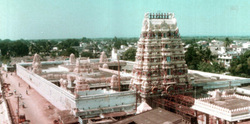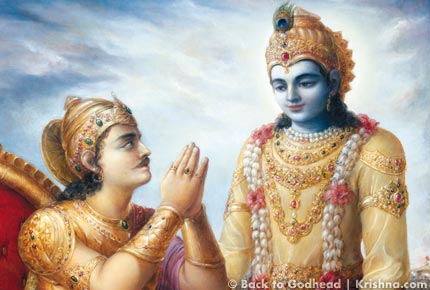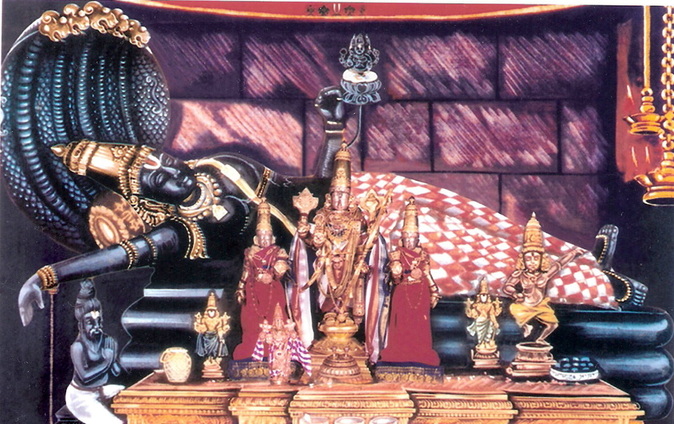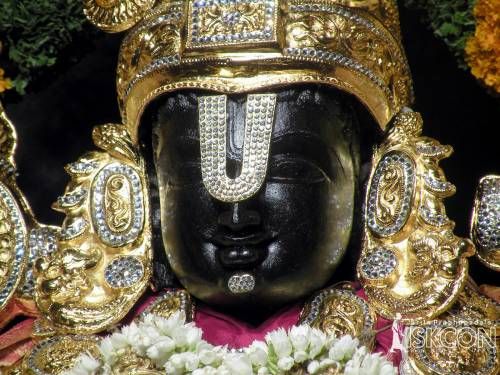A Fitting Lesson to the First Servant
Episode 11
Part 1
Which is the more sacred of the two - the 'laddu' atop the Tirumala Hills or the salt at the feet of Tiruvallur Veera Raghava Swamy? Can a mere mortal sit in judgement on such an issue?
"Vidyavinaya sampanne brahmane gavihastini
Sunichaiva swapakecha panditha samadarsinah"
Many interpret this Lord Krishna's counsel to Arjuna, as expressed in the Bhagavadgita 'sloka', to mean that one should treat all life forms equally. In fact, 'sama' here does not connote equality. 'Sama; here implies "Lord Himself" as defined by Lord Krishna in an earlier 'sloka'. 'Sama' is one of the thousand names of the Lord in 'Vishnu Sahasranama'. It means that one should be able to see the same God that is present in every being. The God in the comman man, and the pundit, rich man and the poor man, in the rodent and the elephant is one and the same - there is absolutely no difference in the Lord.
Part 1
Which is the more sacred of the two - the 'laddu' atop the Tirumala Hills or the salt at the feet of Tiruvallur Veera Raghava Swamy? Can a mere mortal sit in judgement on such an issue?
"Vidyavinaya sampanne brahmane gavihastini
Sunichaiva swapakecha panditha samadarsinah"
Many interpret this Lord Krishna's counsel to Arjuna, as expressed in the Bhagavadgita 'sloka', to mean that one should treat all life forms equally. In fact, 'sama' here does not connote equality. 'Sama; here implies "Lord Himself" as defined by Lord Krishna in an earlier 'sloka'. 'Sama' is one of the thousand names of the Lord in 'Vishnu Sahasranama'. It means that one should be able to see the same God that is present in every being. The God in the comman man, and the pundit, rich man and the poor man, in the rodent and the elephant is one and the same - there is absolutely no difference in the Lord.
Preaching is one thing but practising another. Is it easy to digest and assimilate this basic principle contained in our 'sastras'?
Can a TTD Executive Officer, who works in the precincts of Lord Srinivasa of Tirumala - the 'Kaliyuga Vaikuntha' which annually attracts millions of pilgrims and billions of rupees by way of offerings - cultivate such a mature 'samabhavana'? Is it easy for the Executive Officer to practice 'samabhavana' when every one repeatedly call him "the first servant of the Lord", without succumbing to the illusion of it being true?
Can a TTD Executive Officer, who works in the precincts of Lord Srinivasa of Tirumala - the 'Kaliyuga Vaikuntha' which annually attracts millions of pilgrims and billions of rupees by way of offerings - cultivate such a mature 'samabhavana'? Is it easy for the Executive Officer to practice 'samabhavana' when every one repeatedly call him "the first servant of the Lord", without succumbing to the illusion of it being true?
The 'sastras' have clearly explained the rationale behind deity worship. "The statue is not God. We worship not the statue but the godliness in that". God pervades the entire universe. The power in a statue that manifests on its own ('swayambhu') is said to be of the highest order. But there is power (sannidhana of the Lord) in every deity of every temple. The deity's intensity of power, however, depends on the sanctity with which it has been installed as per the tenets of the 'agamas', on the purity and the devotion of founders and the ardent faith of the pilgrims who visit the temple.
God is one and the same all over; there is no difference in His various forms, His capacities and attributes. He is omnipresent, omnipotent and a personification of perfection. This is evident from the above 'sloka'. The difference lies in the intensity of the faith and capacity of those who sanctified a particular idol in a temple. The 'jnani' - the wise - would therefore, perceive God everywhere as 'sama' - the same.
God is one and the same all over; there is no difference in His various forms, His capacities and attributes. He is omnipresent, omnipotent and a personification of perfection. This is evident from the above 'sloka'. The difference lies in the intensity of the faith and capacity of those who sanctified a particular idol in a temple. The 'jnani' - the wise - would therefore, perceive God everywhere as 'sama' - the same.
The illusion of my being the "first servant of the Lord" as Executive Officer made me somehow believe subconsciously that the real God was to be found only at Tirumala, and deities in other temples not so rich and those not patronized by large numbers of pilgrims could not match Lord Srinivasa. I might not have openly articulated it, but deep inside this thought got rooted.
I was once invited to the 'Brahmotsavas' at Veeraraghava Swamy Temple in Tiruvallur near Madras(Chennai , Tamil Nadu). 'Garuda seva' at the Tiruvallur temple is performed at 5-00 am during 'Brahmostavams', unlike at Tirumala, where it is at 9.00 pm. As it would be convenient to reach Tiruvallur from Madras, I proceeded to Madras the previous evening with my wife and children. Early next morning, we were scheduled to leave for Tiruvallur.
I was once invited to the 'Brahmotsavas' at Veeraraghava Swamy Temple in Tiruvallur near Madras(Chennai , Tamil Nadu). 'Garuda seva' at the Tiruvallur temple is performed at 5-00 am during 'Brahmostavams', unlike at Tirumala, where it is at 9.00 pm. As it would be convenient to reach Tiruvallur from Madras, I proceeded to Madras the previous evening with my wife and children. Early next morning, we were scheduled to leave for Tiruvallur.
We had dinner with an uncle of my wife. One of the relatives casually remarked that pilgrims visiting Veeraraghava Swamy traditionally offer salt at the feet of the Lord and jaggery in the temple pond('pushkarini'). Devotees believe that all their hardships melt away like jaggery in water, if they make the offering. I laughed and casually remarked, "Some smart temple Trust Board or executive officer would have hit upon the gimmick to boost the market for salt and jaggery". All of us had a hearty laugh at the joke and retired for the night.
OM NAMO SRINIVASAYA
OM NAMO NARAYANAYA
OM NAMO VENKATESAYA
OM NAMO NARAYANAYA
OM NAMO VENKATESAYA

12 . A Fitting Lesson to the First Servant
18th Feb 2017
18th Feb 2017






